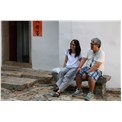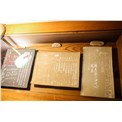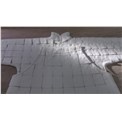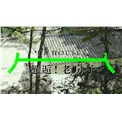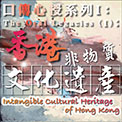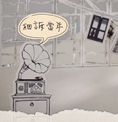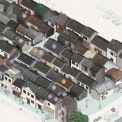-
History & Society
- Education in Pre-war Hong Kong
- History of Taikoo Sugar Refinery
- Hong Kong Products Exhibition
- Local Festivals Around the Year
- Post-war Industries
- Pre-war Industry
- The Hong Kong Jockey Club Archives
- Tin Hau Festival
- Memories We Share: Hong Kong in the 1960s and 1970s
- History in Miniature: The 150th Anniversary of Stamp Issuance in Hong Kong
- A Partnership with the People: KAAA and Post-war Agricultural Hong Kong
- The Oral Legacies (I) - Intangible Cultural Heritage of Hong Kong
- Hong Kong Currency
- Hong Kong, Benevolent City: Tung Wah and the Growth of Chinese Communities
- The Oral Legacies Series II: the Representative List of the Intangible Cultural Heritage of Hong Kong
- Braving the Storm: Hong Kong under Japanese Occupation
- A Century of Fashion: Hong Kong Cheongsam Story
Geography & EnvironmentArt & Culture- Calendar Posters of Kwan Wai-nung
- Festival of Hong Kong
- Ho Sau: Poetic Photography of Daily Life
- Hong Kong Cemetery
- Sketches by Kong Kai-ming
- The Culture of Bamboo Scaffolding
- The Legend of Silk and Wood: A Hong Kong Qin Story
- Journeys of Leung Ping Kwan
- From Soya Bean Milk To Pu'er Tea
- Applauding Hong Kong Pop Legend: Roman Tam
- 他 FASHION 傳奇 EDDIE LAU 她 IMAGE 百變 劉培基
- A Eulogy of Hong Kong Landscape in Painting: The Art of Huang Bore
- Imprint of the Heart: Artistic Journey of Huang Xinbo
- Porcelain and Painting
- A Voice for the Ages, a Master of his Art – A Tribute to Lam Kar Sing
- Memories of Renowned Lyricist: Richard Lam Chun Keung's Manuscripts
- Seal Carving in Lingnan
- Literary Giant - Jin Yong and Louis Cha
Communication & Media- Hong Kong Historical Postcards
- Shaw Brothers’ Movies
- Transcending Space and Time – Early Cinematic Experience of Hong Kong
- Remembrance of the Avant-Garde: Archival Camera Collection
- Down Memory Lane: Movie Theatres of the Olden Days
- 90 Years of Public Service Broadcasting in Hong Kong
- Multifarious Arrays of Weaponry in Hong Kong Cinema
-
History & SocietyGeography & EnvironmentArt & Culture
-
View Oral History RecordsFeatured StoriesAbout Hong Kong Voices
-
Hong Kong MemoryHi! Houses: A Journey into the History of Century-old Houses with the ArtistsRecently Visited
Vernacular Charm of Law Uk in the Eyes of Fiona Wong
The Hakka people may well be described as the first settlers in Chai Wan, and Law Uk Village was one of the earliest villages built there. Two hundred years on, what remain are only this typical Hakka house and the well next to it. Like many other monuments, this old Hakka house has been turned into a folk museum to show how people lived in the past through the display of items in the house. Wong first visited it out of curiosity for discovery. “The common way of display is to create a frozen time frame with the items in a house, as people tend to have a desire to peek, to want to know how other people live.” Visitors can imagine how the former inhabitants lived by examining every nook and cranny of the old house. “Under the kitchen window is a granite slab, about 10 cm deep, fixed into position. It probably served as a countertop for small jars and bottles. This kind of fixture is no longer found in modern homes, so it reflects a very different approach to life in former days.” Fiona Wong is adept at retrieving precious information embedded in the details, in line with her sensitive, delicate artistic style. She examines in detail the life history of a community, often with insight, and then presents these unique perspectives through her installation.
Wong made the acquaintance of Mr Wong Hung-keung, who works in historical building restoration, by chance. Not only is he an expert in Hakka architecture, he was a neighbour of the Law family when he was little, and often visited and played there. His actual experience helped Wong to learn more about Law Uk. “According to Mr Wong, that area around Law Uk was still the countryside during the 1960’s. There were lots of fruit trees, paddy fields in front of the houses, and the seaside was only a stone’s throw away. The factory buildings today are all standing on reclaimed land. Mr Wong and Mr Law Wan-yeung, the relative of the master of the house Mr Law Sing, grew up together as young boys. They used to spend time together, chatting or sometimes sailing out to sea on a boat they built themselves. His old friend has since passed away. Such is the change of the times, and the area around Law Uk is no longer like what it used to be,” she said.
A dialogue between man in the present and the house of a bygone age
“It is difficult to jump the time gap and imagine things of a hundred years ago. When old things are presented in an isolated way in a modern context, the visitor tends to be assigned as the bystander role, looking at history and following a story but feeling totally alienated.” Folk museums in general follow a particular formula where traditional furniture is displayed in a room setting. This creates the impression that the place is deserted. Wong thinks an old house should not get stuck in a time warp; instead, new elements should be injected into a historical monument like this to bring out contemporary people’s passionate yearnings for a home. A space should be created where visitors can ply between history and art from a new perspective, and reflect how they can connect to an old house.
When she was in Law Uk, Wong found the windows too small, making the interior dark and stuffy. This architectural element is in sharp contrast to modern structures of introducing as much light as possible into living spaces. “If this house were mine, I would throw all those windows open.” So she resorted to the use of translucent porcelain to hang on walls to simulate windows with views. “Imagining myself living in Law Uk, I placed a potter’s wheel and work bench next to the barn and the farming implements. I wanted to juxtapose the old and the new, farming and pottery-making, craft and labour, all of which should give an ethos of people living close to the earth. I wanted to create a kind of contrast to link up the past with the present.” She has juxtaposed the old and the new in her installation narrative to recount the stories of the Law Uk inhabitants.
Insights from an elderly Hakka lady
Since she was a young girl, Wong had been deeply impressed by women working on construction sites. She only knew later that the women wearing those beautiful hats with black curtain fringes were Hakkas. This was contrary to the traditional Chinese concept about division of duties in a family, that is, ‘men should work outside and women would tend the home’, so it was generally the men who were responsible for heavy manual work. What she discovered about the Hakka women workers made Wong admire them for their ability to balance between strenuous and delicate work. Very much the men’s equal in ability, they are powerful exponents of the role of women in society. Whether it is inside the home, heavy manual work, or even fine embroidery and handicraft, they can all manage, ‘upholding half the sky’ as the saying goes. Fiona Wong and Chan Kiu-hong also envisaged putting in pavilions after the style of the Hakka sunhat in front of the Law Uk, so visitors can take shelter there from the rain.
The Hakka women as a capable and hardy lot have inspired Wong to explore the Hakka spirit vis-à-vis universal cultures. She wants to re-enact an ethos and mode of behaviour in the old house, which are different from those of the traditional Han women. “I once saw an interview with an elderly Hakka lady. Though life was hard, she felt content. She made herself happy by singing the Shan Ge (or folk songs), and more than that, she not only sang to give vent to her feelings and be happy, she also composed her own songs, which made her virtually a ‘singer-songwriter’! She even kept abreast of the times by creating Hakka songs on topical issues and social themes and performing them in public. Her granddaughter would record the lyrics. Perhaps all creative artists should learn from her and give her kudos.” Artists often tell stories through objects. Wong attempts to turn Hakka folk songs into tangible objects, attach on the screen made by local carpenter Lam Che and present them in Law Uk. The purpose is to create an interesting dialogue in a historical context by juxtaposing the virtual and the real, the visions and the sounds. She etched the Hakka song lyrics on porcelain tiles, then placed it in a light-infused spot in the room, with the lyrics showing subtly against the light and telling touching stories about the people.
“Two hundred years ago, when Law Uk was built in its time, it was only an ordinary house. Time has washed away everything around it and put in high rises, but Law Uk remains unmoved, like a snapshot from history that deeply impressed.” It is perhaps its destiny that Law Uk is still standing proudly in this metropolis, with its stoves and firewood intact despite the ravages of time, upholding and showing us the hardiness and steely spirit of a centuries-old community. It is a new take on an old story as well as a legend.
Photos
Copyright © 2012 Hong Kong Memory. All rights reserved.






